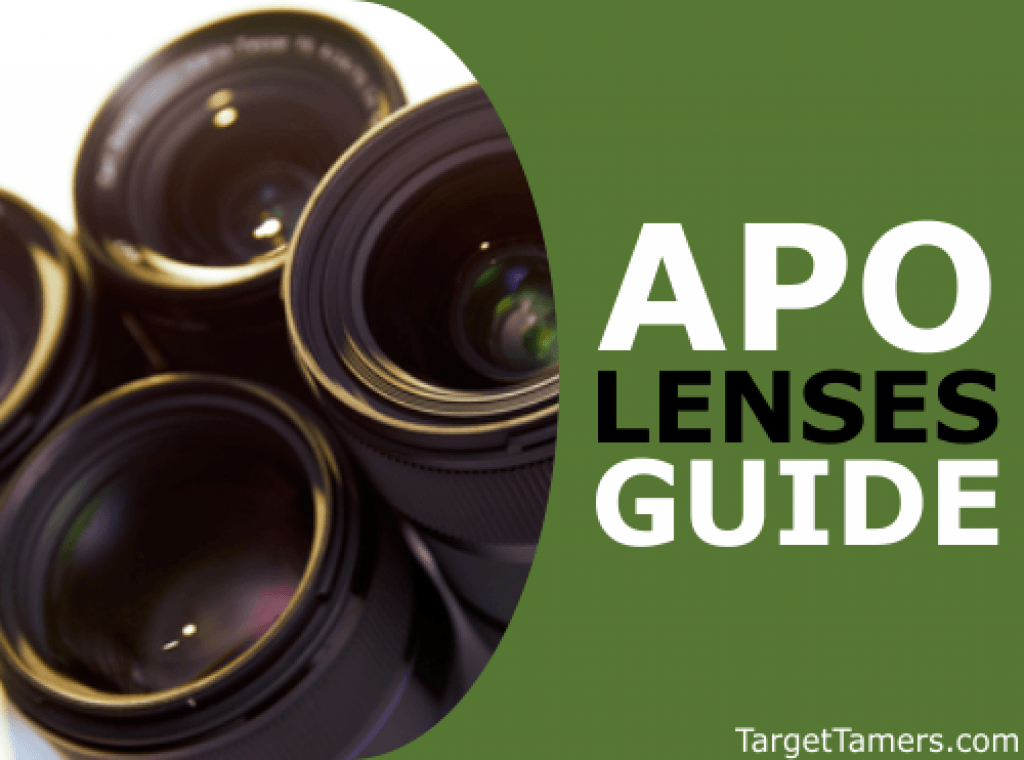
Achromatic, apochromatic, extra-low dispersion, and fluorite glass. What does it all mean? Is it all the same thing?
While there are many high-end manufacturers that offer apochromatic (APO) lenses, it's very difficult to find a full explanation of what it is to a T.
Let us indulge your curiosities as we get into what an APO lens is, what the benefits are, and how it can make for a better glassing experience!
Dispersion - What is it?
What we know as "white light", like regular daylight, may seem colorless to our visible eye. However, white light actually contains all the wavelengths of the visible color spectrum. While each wavelength is just as intense as the other, color "sharpness" and fidelity through hunting optics can be diminished because of the glass. How?
When light travels through the prism system/glass elements, the wavelengths become distorted and dispersed. This means that each wavelength is broken up and they each land in various distances among the focal plane of the optic. This results in aberration. You will notice this as color fringing and spherical aberration. What does this mean for you?
- Color Fringing: Bright to dark transitions in the image, especially where you see highlights, are distorted. The edges or the fringes will be colored and soft.
- Spherical Aberration: The quality of the image is compromised. The entire image may seem softened and lacking sharpness.
Images Source: Nikon
Why You Need Apochromatic Lenses
Since we know what the problem is, solving it comes by reducing the aberration by reducing the dispersion. How is this done? Well, without getting into the specifics of glass quality itself (more on this later), let's dive right into the different types of chromatic lenses.
1. Monochromatic
Also known as a compound lens, it uses a single lens to correct for one wavelength. However, chromatic aberration remains uncorrected since we are still yet to correct for a broader spectrum of wavelengths (colors).
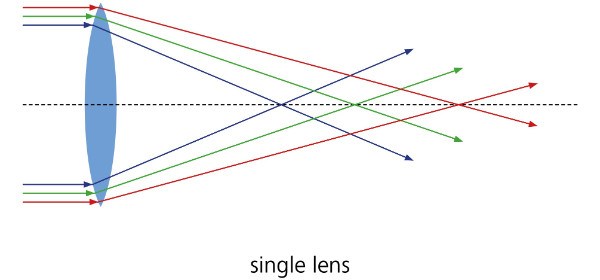
2. Achromatic
Also known as an achromatic doublet, it uses a series of two lenses: one convex lens and one concave lens. The convex lens will be made with some sort of crown glass. It corrects for two wavelengths, blue and red, by bringing them together to land in the same distance of the focal plane. This reduces chromatic aberration for two wavelengths and one wavelength for spherical aberration.
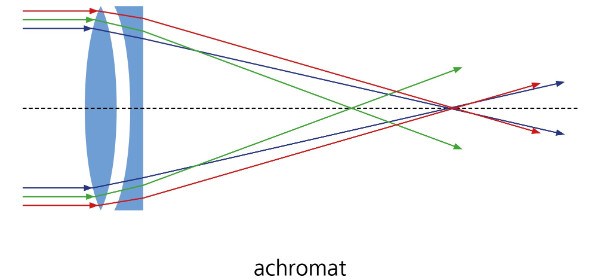
3. Apochromatic
Also known as an apochromatic triplet, it uses a series of three lenses. It provides better correction of aberration and significantly reduces dispersion versus monochromatic and achromatic lenses. It corrects for three wavelengths: blue, red, and green to reduce chromatic aberration, and it corrects for two wavelengths to reduce spherical aberration. It also consists of some type of fluoride elements, special lens coatings, and flint lenses to bring the wavelengths into the same focal plane.
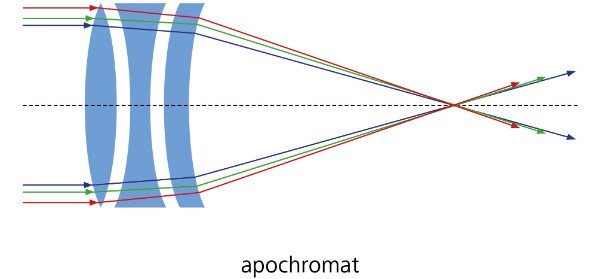
Images Source: Zeiss
4. Superachromat
Not yet seen on hunting optics. It's typically used to provide flawless image quality by correcting dispersion for four wavelengths. While it sounds tempting to upgrade hunting optics to superachromatic lenses, it's not necessary. It can also introduce new issues such as sensitivity to various factors that affects image quality and focusing.
As you can see, APO lenses are better than achromatic lenses, and achromatic lenses are better than monochromatic lenses. With the best quality glass, it can completely eliminate aberrations and make for an excellent and comfortable glassing experience. The Leica APO-Televid 82 spotting scope is one of the best optics in the hunting optic industry. With a brand like Leica, you're guaranteed to have unsurpassed image quality when they promise you an optic with APO lenses.
Benefits of APO Lenses
- Three correctly aligned wavelengths
- Reduced chromatic aberration
- Reduced spherical aberration
- Improved color contrast
- Improved image sharpness
- Reduced eye strain
- Comfortable glassing for longer periods of time
Drawbacks of APO Lenses
- More difficult to make
- Involves costly materials
- Expensive to purchase
- Consists of more glass
- Consists of more glass elements
- Increases overall weight of optic
While the drawbacks might mean more weight and a higher purchase price, the image quality is practically flawless. If you're a serious hunter with deep pockets, you'll appreciate the quality craftsmanship that goes into producing such a fine optic. One such fine optic is the Vortex 12X50 Razor HD binocular that integrates much more than just APO lenses. It also has phase correction coatings, HD elements, ED glass, and XRPlus fully multi-coated lenses to allow for the best image quality possible.
What APO Is Not
It's all too easy to get confused with this and that term when narrowing down on the features of a hunting optic. But, since we've covered what APO correction is, let's define it a little more by identifying its often-close counterparts that can muddy the waters a little when all you want is clarity.
What is ED Glass?
You can't talk about APO lenses without mentioning Extra-Low Dispersion (ED) glass. While it's easy to mistake them for being the same thing, since they essentially provide the same aberration-free benefits, they're not.
When you have achromatic or APO correction and lenses, you almost always have ED glass. While APO refers to the actual number and types of glass components that make up the glass system in a prism, ED refers to the actual glass materials the glass system can be made with.
ED glass has elements in it that can correct for aberrations. It can also help to maintain color fidelity by the time the light reaches your eye. The image in general will be bright, true, and sharp. In conjunction with APO correction, the image quality is unparalleled. Just check out what the combination of both ED and APO glass looks like through the NightForce TS-82 20-70X Spotting Scope! It's worth every second of your glassing time.
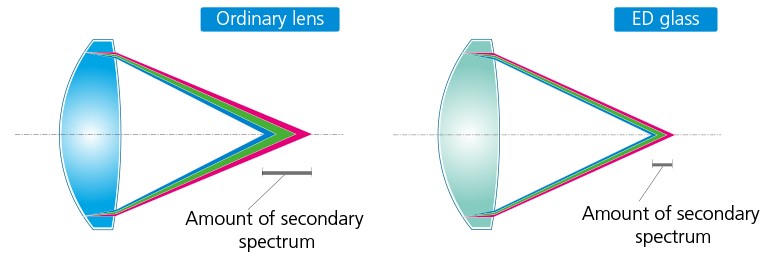
What is Fluorite Glass?
Now, what about fluorite glass? Fluorite crystals are almost always used in the best glass available. Why? Fluorite has a very low dispersion rate meaning that it won't scatter light waves when it hits the glass as much as conventional or standard glass would. It aids the process of APO lenses to reduce chromatic aberration.

Additionally, whenever you have some sort of fluorite crown glass, you almost always have ED or HD glass quality. But, even if you have ED/HD quality, it doesn't necessarily mean you have fluorite glass.
ED glass can be made without fluorite, so it's always best to do as much research as you can on the process of how you have the quality glass that you have. You can do this by being brand specific. Brands like Vortex, Zeiss, Leica, Nikon, and many more offer quality glass with the best components in the glass industry.
Does Quality Glass Matter?
At this point, you should already know the answer to this. Currently, there isn't a universal standard to judge APO lenses equally. Each manufacturer can coin their own standards to qualify it as an APO optic. Here's a few tips on how to know if you're getting your moneys worth.
- Be brand specific.
- Look at the quality of the glass. Ex. ED/HD glass, BaK4 glass.
- Look for specialized glass coatings. Ex. phase correction, dielectric, fully multi-coated, etc.
- Research the prism system of the optic.
- Compare prices and weight.
- Try to get hands-on experience before buying.
If you want to know how BK7 and BaK4 glass hold up against each other when it comes to dispersion, refractive rates, and all that good stuff related to superior image quality, see our Binocular Glass 101 article.
Glass With The Best, See The Best!
Acquiring an optic with APO correction and lenses certainly means you're going to have the best Glassing experience possible. It will cost you, but what's a few extra hundred bucks when you have the image quality of a bird's eye view?
It's all about how an optic and its glass interacts with and maximizes light. It just might mean the difference between capturing a once-in-a-lifetime moment, a one-shot first-shot kill, or being completely oblivious to the herd around you because you can't see a darn thing. When you glass with the best, you see the best!
Further Reading





